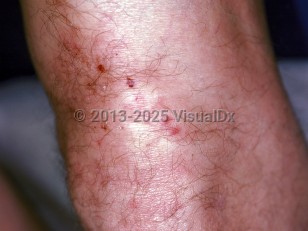Dermatitis herpetiformis in Child
Alerts and Notices
Important News & Links
Synopsis

The cutaneous lesions seen in childhood are similar to those in adults, with symmetric papulovesicular eruption on the extensor surfaces and buttocks that is extremely pruritic and may wax and wane in severity. Facial involvement has been reported. Pruritus and nonpruritic, noninflammatory papules and pruritic purpuric macules / petechiae on the palms can be a rare presentation with or without the typical papulovesicular eruption.
About 80%-95% of children with DH have gluten-sensitive enteropathy on small intestine biopsy. Most are asymptomatic and undiagnosed at presentation of DH; only 10% of children carry a previous diagnosis of celiac disease.
There is an increased incidence of autoimmune diseases in patients with DH. The most common associated autoimmune conditions include thyroid dysfunction, particularly Hashimoto thyroiditis, type 1 diabetes mellitus, and pernicious anemia. Patients with DH are at an increased risk of developing enteropathy-associated T-cell lymphoma. However, a gluten-free diet may be protective against cancer development.
Codes
L13.0 – Dermatitis herpetiformis
SNOMEDCT:
111196000 – Dermatitis herpetiformis
Look For
Subscription Required
Diagnostic Pearls
Subscription Required
Differential Diagnosis & Pitfalls

Subscription Required
Best Tests
Subscription Required
Management Pearls
Subscription Required
Therapy
Subscription Required
Drug Reaction Data
Subscription Required
References
Subscription Required
Last Updated:01/12/2022

